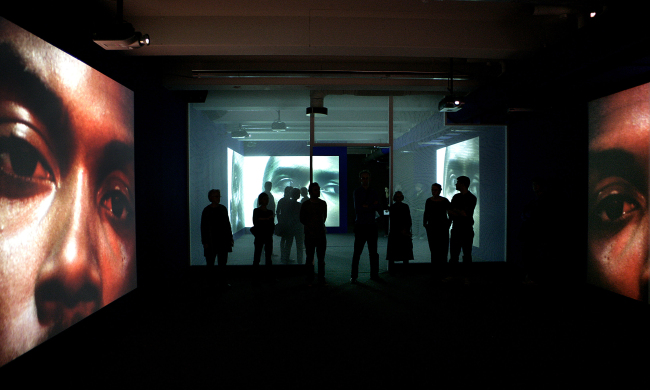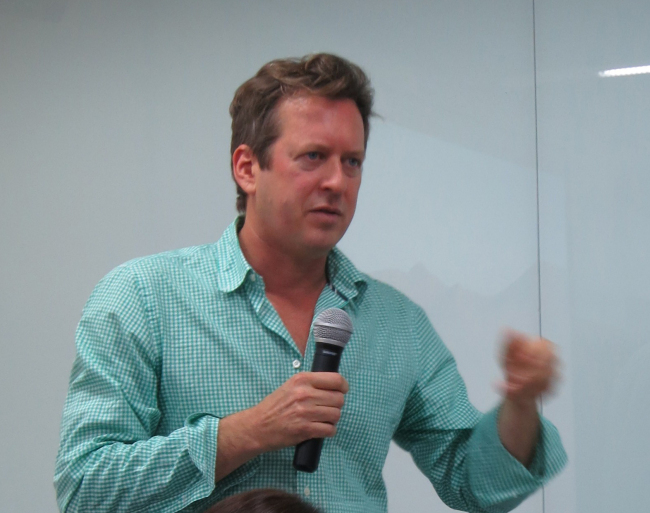‘DNA of modern media artists comes from Nam June Paik’
By Lee Woo-youngPublished : Nov. 14, 2013 - 20:22

Nam June Paik was an artist ahead of his time and his influence on today’s media artists is greater than when he was alive in the 80s and 90s, according to Doug Aitken, winner of the 2012 Nam June Paik Art Center Prize.
“Paik was incredibly ahead of his time ... his works were about mixing up the media and this has been the DNA of today’s media artists,” said Aitken at the press opening of his exhibition at Nam June Paik Art Center in Korea last week.
Aitken was awarded the NJP Art Center Prize in 2012, a prize that recognizes artists with experimental and innovative works that contribute to expanding the boundaries of art. The NJP Art Center is holding his solo exhibition until Feb. 9, 2014 that continues the legacy of Nam June Paik.
“It is the first time the NJP Art Center has shed light on a living artist. Aitken has been ahead of his time too because he did a multi-channel video installation in 1999,” said Park Man-woo, director of the NJP Art Center.
“Paik was incredibly ahead of his time ... his works were about mixing up the media and this has been the DNA of today’s media artists,” said Aitken at the press opening of his exhibition at Nam June Paik Art Center in Korea last week.
Aitken was awarded the NJP Art Center Prize in 2012, a prize that recognizes artists with experimental and innovative works that contribute to expanding the boundaries of art. The NJP Art Center is holding his solo exhibition until Feb. 9, 2014 that continues the legacy of Nam June Paik.
“It is the first time the NJP Art Center has shed light on a living artist. Aitken has been ahead of his time too because he did a multi-channel video installation in 1999,” said Park Man-woo, director of the NJP Art Center.

Part of the exhibition is Aitken’s work “Electric Earth” that won him a Golden Lion at the 1999 Venice Biennale. The eight-projection installation is played out in four different rooms: The first and last rooms play one video each and the two in the middle play three videos each. Viewers move from one room to the next immersed in the world of the protagonist Aitken created, who is the last person on earth.
As the protagonist moves from space to space, the consequences of time feels longer than the original running time, which is 9 minutes and 50 seconds. The black man’s choreographic movements in harmony with his heartbeat and the background music are seamlessly connected, leading viewers to experience an expanded dimension of time and space.
“When you walk through it, it creates the separation from the reality, the museum you are in and the city you are in. It feels timeless there,” explained Aitken.
Aitken has explored diverse uses of mediums for his works of art, ranging from photography, print media, sculpture, installation, film and sound, to performance. He beamed a large-scale projection on the outer walls of buildings on a Manhattan block for his 2007 “Sleepwalkers.” He also aimed high-definition projectors at the exterior of the cylindrical wall of the Hirshhorn Museum in Washington, D.C. for “SONG 1” in 2012. His latest project was a site-specific happening in which a train travels from the Atlantic to the Pacific in the U.S.
For more information, visit www.njpartcenter.kr.
By Lee Woo-young (wylee@heraldcorp.com)
As the protagonist moves from space to space, the consequences of time feels longer than the original running time, which is 9 minutes and 50 seconds. The black man’s choreographic movements in harmony with his heartbeat and the background music are seamlessly connected, leading viewers to experience an expanded dimension of time and space.
“When you walk through it, it creates the separation from the reality, the museum you are in and the city you are in. It feels timeless there,” explained Aitken.
Aitken has explored diverse uses of mediums for his works of art, ranging from photography, print media, sculpture, installation, film and sound, to performance. He beamed a large-scale projection on the outer walls of buildings on a Manhattan block for his 2007 “Sleepwalkers.” He also aimed high-definition projectors at the exterior of the cylindrical wall of the Hirshhorn Museum in Washington, D.C. for “SONG 1” in 2012. His latest project was a site-specific happening in which a train travels from the Atlantic to the Pacific in the U.S.
For more information, visit www.njpartcenter.kr.
By Lee Woo-young (wylee@heraldcorp.com)







![[Graphic News] More Koreans say they plan long-distance trips this year](http://res.heraldm.com/phpwas/restmb_idxmake.php?idx=644&simg=/content/image/2024/04/17/20240417050828_0.gif&u=)
![[KH Explains] Hyundai's full hybrid edge to pay off amid slow transition to pure EVs](http://res.heraldm.com/phpwas/restmb_idxmake.php?idx=644&simg=/content/image/2024/04/18/20240418050645_0.jpg&u=20240419100350)





![[From the Scene] Monks, Buddhists hail return of remains of Buddhas](http://res.heraldm.com/phpwas/restmb_idxmake.php?idx=652&simg=/content/image/2024/04/19/20240419050617_0.jpg&u=20240419175937)

![[KH Explains] Hyundai's full hybrid edge to pay off amid slow transition to pure EVs](http://res.heraldm.com/phpwas/restmb_idxmake.php?idx=652&simg=/content/image/2024/04/18/20240418050645_0.jpg&u=20240419100350)

![[Today’s K-pop] Illit drops debut single remix](http://res.heraldm.com/phpwas/restmb_idxmake.php?idx=642&simg=/content/image/2024/04/19/20240419050612_0.jpg&u=)